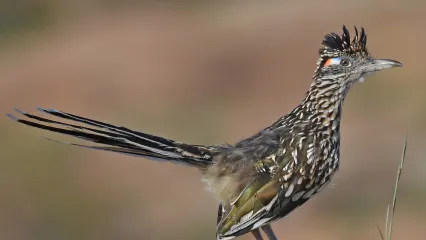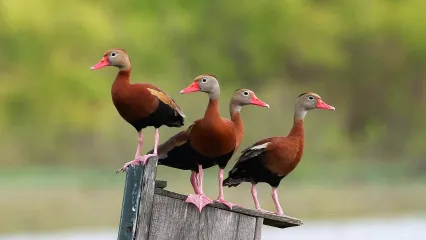
Description
The greater roadrunner (Geococcyx californianus) is certainly one of Oklahoma's most fascinating birds to watch. Powerful legs, a long tail, oversized bill and shaggy crest give the birds a prehistoric flair that makes them unmistakable among the state's avian residents.
Roadrunners came by their name naturally. They can sprint up to 20 miles an hour, and will only fly as a last resort. They are actually members of the Cuckoo family, which may explain the comical antics they often perform. They are, however, intelligent creatures and are quite curious about human activity, often shaking their tail from side to side as they try to figure out what we humans are doing.
These crow-sized predators are skillful hunters and are not picky about what they eat. A roadrunner's diet consists of about 90 percent animal matter; the remainder is fruit and seeds. Roadrunners are perhaps best known for their appetite for snakes, but they will eat anything they can kill with their sharp beak, including lizards, rodents, insects and even other birds. They often control animals that are considered pests.
Roadrunners often live in extreme climates and are uniquely adapted to conserve energy. On cool nights, they lower their body temperature and become lethargic. In the morning, they use a built-in heat exchanger, a patch of dark skin on the back between the wings, to help absorb the warmth of the rising sun. They manipulate their feathers to expose the patch, then find a suitable sunning place and wait for their body to reach normal temperature.
These entertaining birds are not particularly vocal , but they have a wide repertoire, from soft dove-like coos to low, guttural notes to sharp, high-pitched barks. The next time you are in Oklahoma's outdoors and you see the bright yellow eyes of the roadrunner checking you out, take a minute to look back. You might be pleasantly surprised at what you see.
Size
The grater roadrunner can grow to lengths of 52 to 62 cm.
Habitat
Greater roadrunners prefer open country with little brush to slow them down. That is why they can often be seen along roadsides. At one time, roadrunners were considered birds of the desert southwest, but their range has expanded east through Oklahoma into Louisiana and Arkansas
Life Cycle
Roadrunners may look tough, but they are attentive and meticulous parents. During the spring, a male roadrunner can often be seen carrying a lizard or small snake as an offering to attract a mate. Although they spend most of their lives on the ground, the parents will build a nest up in a tree where the female lays four to five nearly spherical white eggs The parents share the incubating duties and once the eggs hatch, they are both busy feeding their voracious youngsters The chicks are ready to leave the nest when they are around three weeks old, but their parents will continue to teach them how to hunt for several more weeks.


